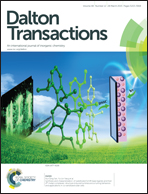Pyridine versus acetonitrile coordination in rhodium–N-heterocyclic carbene square-planar complexes†
Abstract
Experimental and theoretical studies on the factors that control the coordination chemistry of N-donor ligands in square-planar complexes of the type RhCl(NHC)L1L2 (NHC = N-heterocyclic carbene) are presented. The dinuclear complexes [Rh(μ-Cl)(IPr)(η2-olefin)]2 {IPr = 1,3-bis-(2,6-diisopropylphenyl)imidazol-2-carbene} have been reacted with different combinations of ligands including pyridine, acetonitrile, 2-pyridylacetonitrile, triphenylphosphine, tricyclohexylphosphine, carbon monoxide or molecular oxygen. In addition, the reactivity of RhCl(IPr)(PPh3)2 has also been studied. Pyridine preferentially coordinates trans to the carbene ligand whereas π-acceptor ligands (olefin, CO or PPh3) are prone to bind cis to IPr and trans to chlorido, unless steric bulk hinders the coordination of the ligand (PCy3). In contrast, acetonitrile is more labile than pyridine but is able to form complexes coordinated cis-to-IPr. Molecular dioxygen also displaces the labile cyclooctene ligand in RhCl(IPr)(η2-coe)(py) to give a square-planar dioxygen adduct which can be transformed into a peroxo derivative by additional coordination of pyridine. Charge decomposition analysis (CDA) shows that σ-donation values are similar for coordination at cis- or trans-IPr positions, whereas efficient π-backbonding is significantly observed at cis position being the favoured coordination site for π-acceptor ligands. The Rh-IPr rotational barrier in a series of square-planar complexes has been analysed. It has been found that the main contribution is the steric hindrance of the ancillary ligand. The presence of a π-donor ligand such as chlorido slows down the dynamic process.



 Please wait while we load your content...
Please wait while we load your content...